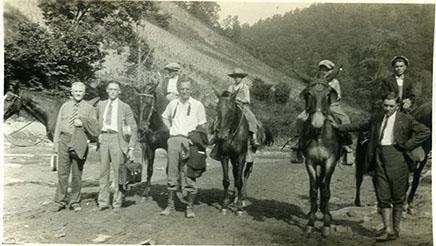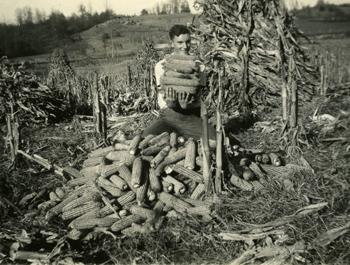Celebrating KY 4-H History in 1909-1919
Planting The Seed

The seed planted by the Fayette County Corn Club of 1909 produced not only a crop of corn, it produced a bountiful harvest which we know today as Kentucky 4-H. Kentuckians can give credit to Nannie G. Faulconer, Superintendent of Fayette County Schools, and George Roberts of the Kentucky Agricultural Experiment Station, who saw a need and found a creative way to meet that need.
While the Extension services of land grant colleges were providing free bulletins on the results of their research and experimentation, they were not seeing the increase in crop production that they knew was possible. Faulconer and Roberts organized a group of boys, each of whom agreed to grow one acre of corn and report his corn yield and production cost at the end of the season. From that successful beginning, Extension personnel chose what was later to be called Junior Agricultural Clubs as one avenue to promote their services.
Kentucky was not the first state to have such clubs. Ohio started the first club in 1902. The first club work in the south probably began in Mississippi in 1907 at a time when the boll weevil had become a serious threat to cotton-growing states. Dr. Seaman Knapp of the United States Department of Agriculture was assigned the task of helping these states. Dr. Knapp believed that southern states should adjust to their situation by growing corn and he wisely chose the corn club concept as a way to demonstrate the practicability of corn as a crop. It must have been his success that inspired other states, including Kentucky, to organize corn clubs and provide recognition as an incentive for further participation. As early as 1909, a trip to Washington, D.C., was offered to state corn club champions in many states. Those winners going to Washington were presented with diplomas by the Secretary of Agriculture. And so began 4-H club work and its principle of recognition for success of projects well completed.
Dr. Roberts continued to promote corn clubs until 1910 when T.R. Bryant, professor and head of Extension work for the College of Agriculture, University of Kentucky, took over the club work. About this same time, Dr. Fred Mutchler of the Western Normal School in Bowling Green began working with corn clubs and over the next few years, several thousand members were enrolled.
Thus was planted the seed of Kentucky 4-H.
Taking Root
According to J.W. Whitehouse, who became State Leader of Boys' and Girls' Club work in February 1924, Prof. George Roberts, Agronomist at the Experiment Station, did much to encourage corn clubs during the years 1909 to 1911. Other persons also took interest in the work at that time. Commissioner of Agriculture Rankin encouraged the work and arranged to give free seed corn. In 1910, Professor T.R. Bryant, Head of Extension Work of the College of Agriculture, took over club work and during the years 1911, 1912 and 1913, a number of clubs were organized under his direction. In 1912 a handbook was issued from the College for this work. This was the first Kentucky publication on the subject.
The leadership of this work was, however, not centered in any one place. Dr. Fred Mutchler of the Western Normal School, Bowling Green, Kentucky, also did some work with corn clubs, beginning about 1911. Several thousand members were enrolled under his leadership.1

On the heels of corn clubs, other similar clubs became prevalent: pig clubs, poultry clubs and canning clubs. Pig clubs began in 1911; poultry clubs and canning clubs for girls began in 1912. Extension endeavors at this time were accomplished primarily through printed circulars and personal correspondence or visits by college faculty.
Agents were employed by the Extension Department in 1912 to organize the poultry and pig clubs and a special agent was hired to oversee the corn clubs. In 1914, several female agents were hired to oversee the canning clubs, most of them working just during the canning season. (Home demonstration agents did not appear on the scene until 1914.)
The Introduction of Competitive Events
Agricultural Extension leaders apparently wanted to take advantage of the very successful club movement and in 1912 provided a new incentive for excellence among the members of boys’ clubs. This incentive took the form of a boys’ camp held at the State Fair Grounds. Based on an arrangement with the State Fair Board, boys who had excelled in club work were appointed by the Superintendent of Extension to attend the camp, with the Fair Board paying the expenses. The boys slept in tents furnished by the National Guard, with straw spread on the ground for beds.
About 100 boys attended that first camp in 1912, a significant endeavor for all concerned! The boys were invited to bring their corn, poultry, pigs and cattle to the fair to compete for prizes. Judging rings set up for that year were maintained as standard procedure for years to come.
A 4-H educational exhibit was introduced at the fair in 1913. Other activities such as judging contests were quickly introduced.
The Clover and the Four H's
There seems to be some question about the origin of the clover as the club emblem, but according to Whitehouse:
"but from the best authorities it seems that O.H. Benson, one of the early club leaders in Iowa, used a three-leaf clover to label packages of seed corn that the corn club members had for sale. To this three-leaf emblem O.B. Martin of the U.S. Department of Agriculture, added the fourth leaf, and formed the design of a four-leaf clover with an "H" in each leaf. This was done about 1912 and the first badges and labels with the 4-H insignia were used about 1914. In 1924, a patent on the 4-H club design was granted to the Director of Extension in the U.S. Department of Agriculture. Under this patent it is unlawful for any person, without the consent of the Director of Extension to use the 4-H design on any manufactured article offered for sale.2
Kentucky called its clubs “Boys’ Corn Clubs,” “Girls’ Canning Clubs,” “Boys’ and Girls’ Club Work,” “Junior Agricultural Club Work,” “Boys’ and Girls’ 4-H Club Work” and “4-H Club Work” until 1928 when it changed the name to “Junior 4-H Club Work.” The 4-H emblem had been in use in Kentucky for more than 10 years.
Defining the Structure of 4-H Club Work
While the face of 4-H has changed to meet the challenge of the times, the early national organizers established a structure for the 4-H program that has, in its essence, endured down through the years. At least three principles of the 4-H program emerged early in the embryonic stages of the new organization: (1) demonstrations, (2) records and reporting and (3) member ownership. The following are excerpts from Early History & Development of 4-H Work. More…
Demonstrations
In 1910, Club girls in South Carolina gave demonstrations in canning tomatoes. Soon club members were giving demonstrations on testing seed corn. Later, members in teams or individually gave demonstrations in selection of materials, stain removal, selecting and cutting seed potatoes and dozens of other subjects.
Records & Reporting
By 1911 club work was growing rapidly, but there was no authentic way by which members reported their work or how many actually carried their work to completion.
In 1912, leaders of state agents, meeting in Washington, D.C., decided that club members must agree not only to carry out the educational features of their farm and home work, but that they must keep records as well. The state agents agreed that records should be kept in three parts: the beginning or preparation and planting of the crop, cultivation of the crop, and a final records form filled out at the end of the project. Similar records were devised for the girls’ projects and other farm projects. It is significant that the work the youngsters did was called “projects,” the term that is still in use today.
Member Ownership
Representatives of the USDA, teachers, 4-H agents, and others insisted that not only should a boy or girl produce higher yields of corn, cotton, rice, garden products or canned tomatoes, and learn to sew, but that the products should belong to the boys and girls. The idea of ownership spread throughout club work and gave a tremendous push to the club idea.3
Toward the End of the Decade
The work of 4-H was well entrenched by the time the Great War began—the war to end all wars. By 1917, there were 3,887 boys and girls enrolled in 4-H in 42 Kentucky counties, members were growing better pigs and corn, and canning was now being done in tin cans.
The big thrust for 4-H during those war years was signified by the slogan “Food Will Win the War.” Membership grew during the war years with more and more rural youth becoming 4-H members.
Preceding and during the war years, a significant change in the direction of 4-H began fermenting. From its beginning, girls’ club work had been administered through home demonstration under the leadership of Helen B. Woolcot, who had been employed as state leader of canning club work in 1913. Boys’ club work had been administered by the agricultural arm of Extension since 1915 under the leadership of Otis Kercher, state leader of boys’ clubs. (Fred Mutchler, who early on had worked with corn clubs in Western Normal School at Bowling Green had been named Superintendent of Extension work in 1914 following passage of the Smith-Lever Extension Act.) Kersher, in 1918, began pushing for an identical program for both boys and girls which would meet school requirements and merit school credits.
Kercher felt that both boys and girls “should be allowed the privilege of becoming identified with any club project for which we can supply supervision and instruction.” He further suggested that the two branches should be under the direction of one person. At least part of the impetus for his suggestions was the vocational education program in high schools provided for by the Smith Hughes Act of 1917.
Kercher’s recommendations apparently were received positively, and when he resigned his position in 1919, his title was State Leader of Boys’ and Girls’ Club Work. According to Smith:
He was followed by Frank N. Barrett, who was moved up from assistant in boys' club work to state leader of junior clubs, but who resigned effective June 1, 1920. Barrett was in turn followed by Carl W. Buckler, who also had been an assistant in boys' club work. Buckler resigned January 31, 1924, to be followed on February 1 by James William Whitehouse, one of the assistant supervisors of county agricultural agent work. The title under which Whitehouse was employed in 1924, State leader of Junior Club work, remained his official title on the USDA appointment forms throughout his period of service, ending with his retirement July 1, 1956, though for many years he was designated in Kentucky as Head, 4-H Club Department. 5
1 Paper by J. W. Whitehouse
2 Paper by J. W. Whitehouse
3 Paper: Early History and Development of 4-H Work, unknown author, undated
4 Smith, J. Allan. 1981. College of Agriculture of the University of Kentucky: Early and Middle Years 1865-1951, 166. Lexington, KY: Kentucky Agricultural Experiment Station.
5 Smith, J. Allan. 1981. College of Agriculture of the University of Kentucky: Early and Middle Years 1865-1951, 166. Lexington, KY: Kentucky Agricultural Experiment Station.
Additional Resources
Historical Sketch of Extension Work in Kentucky by T.R. Bryant, May 1939
Early History and Development of 4-H Work State 4-H Department Historical Records
